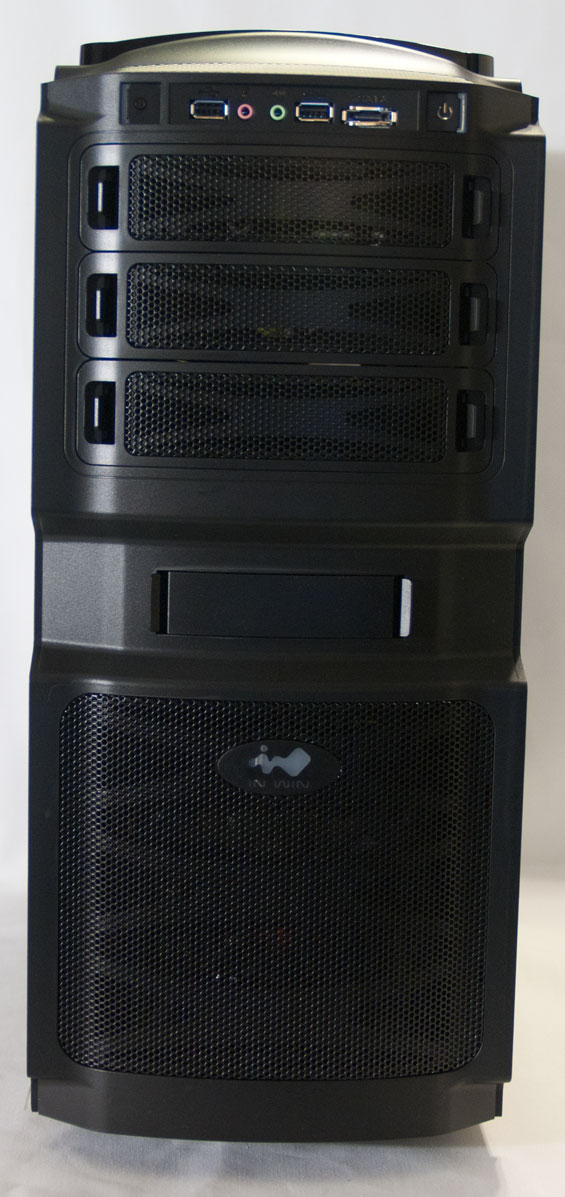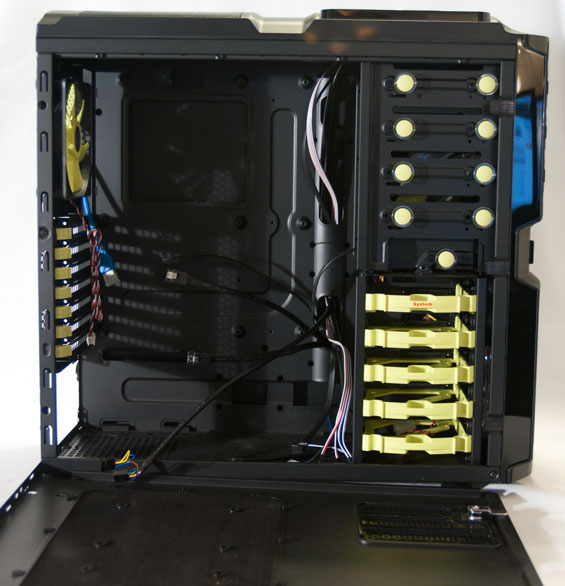IN-WIN BUC: Just How Much $100 Can Buy
by Dustin Sklavos on May 9, 2011 4:28 PM EST- Posted in
- Cases/Cooling/PSUs
- In-Win
- mid-tower
In and Around the IN-WIN BUC
I'll come out and say it: while I don't think it's anywhere near as ostentatious as a lot of gaming-oriented cases can be, the IN-WIN BUC could probably stand a little more understatement. There's no glossy plastic to be found anywhere on this chassis except for a light trim at the top and small side accents, though, and thankfully the lighting is in no way overpowering: the front logo glows red (this can be disabled), and the front fan glows blue. The color scheme is two-toned, with most of the case in black and assembly grommets and trays in a kind of neon yellow-green.
Build materials are the standard plastic and SECC steel one would expect in the price range, but the case feels sturdy and not liable to snap or break anywhere in particular. As we get into this, you'll see places where IN-WIN cut corners to keep costs down and generally speaking they're fairly smart with their approach.

The first thing that struck me when I started playing with the BUC was that it's a largely toolless case design. This is something I think some manufacturers even at the upper end of the field forget we actually appreciate, and what you're going to find is that there's an awful lot of thought given to practicality, ease of use, and flexibility when it comes to this case. The front covers for the 5.25" bays all snap in and out relatively easily, but they're secure enough so they don't rattle and have a squeeze-clamp kind of design that I actually prefer to the drive bay covers I've seen on more expensive cases like Antec's P182/P183 and Corsair's 600T. Practicality is king here.
When you go to open the case up, you'll find that instead of even thumbscrews, IN-WIN has adopted plastic clamps that work surprisingly well. If these aren't to your taste, you can remove them and just use conventional screws/thumbscrews to secure the panels. What I was really pleased with, and a couple of you are going to nod knowingly, is the fact that the side panels slide on and off with a minimum of fuss. I've used a few inexpensive cases where side panels didn't line up quite right or required a lot of force to budge once they were stuck in place.
The main side panel also features ventilation and mounts for two 120mm fans; clearance in the bottom mount is fine for video cards, but there wasn't enough room to put a fan in the top mount with our Zalman CNPS9900 CPU cooler attached. There's a smaller removable piece in the bottom right of the panel that uses a conventional case key; this gives you access to three of the hotswap bays. NewEgg cites the enclosure as having four bays, but that's not entirely true; only the first three can be accessed with the door and the fourth is only accessible if the entire side panel is removed.

Popping open the BUC reveals a largely toolless interior. 5.25" drives are secured by popping out the neon green knobs, sliding the drive in, and then popping the knobs back in--and you only have to do this on the main side of the enclosure. There's a single knob for the external 3.5" bay, and then there are five 3.5" drive trays, four of which connect seamlessly to a SATA backplane.
The motherboard tray has the standoffs for a full ATX board more or less built in, and amen to that. It's been a long time since I've seen a motherboard that uses any kind of nonstandard standoffs, so not having to install those is welcome. Above the motherboard area is an opening where an additional 120mm fan can be installed; two plastic clamps flex open as you insert the fan, and then it more or less locks into place. This felt a little bit loose to me and is definitely vibration prone.
Finally, the expansion bays include one actual removable slot cover, with the rest essentially needing to be bent and snapped off. That's disappointing, but on the bright side each of these have a clamp that rotates outside of the case: no screwing in expansion cards, and our GTX 580 was remarkably secure using these clamps.
















57 Comments
View All Comments
ggathagan - Monday, May 9, 2011 - link
If you look at the pictures, you'll note that it's not really a SATA backplane.It's hot-swap connectors mounted on 4 of the 5 drive bays.
Belard - Monday, May 9, 2011 - link
In-Win has been a rather small company for a very long time. I've built systems with their cases 10 years ago. In general, they do come (and in the past) some very cool designs. But for the most part - in the past 4-6 years, their design have gone towards plain or ugly (IMHO).But I've seen the BUC at a store, and it is a very very nice looking case.
Spivonious - Tuesday, May 10, 2011 - link
My first PC used an In-Win case. It had a Celeron 333A to give you a time frame. :)They've always been a quality, value-oriented case manufacturer.
Belard - Saturday, May 14, 2011 - link
Around that era, I sold some In-Wins. They even had decent PSUs.shamans33 - Monday, May 9, 2011 - link
Nice to see CPU HSF clearance values on the features table.It might be nice to see a list of unusual features onto a table as well (as a summary of key new features)
kmmatney - Monday, May 9, 2011 - link
The only thing I don't like about routing the power supply wiring behind the motherboard is that its a pain if you want to swap it out. I spent a long time routing all my power supply wiring in my case, and then my son's computer had trouble. I suspected the power supply, but needed to put mine into his computer to properly troublshoot. So I had to undo my hard work...jrocks84 - Monday, May 9, 2011 - link
The noise and thermal testing graphs are very helpful for making decisions on cases. Not that many case reviews give this data, so it's nice to see more sites adopting this testing.Ammaross - Monday, May 9, 2011 - link
Anand, perhaps while you're on full ATX cases with backplanes for the hard drives, could you look over the AzzA Hurrican 2000? (yes, no 'e' in 'Hurrican'). I used it recently for my home rig and I think others might like to see your take on it. :)nightalon - Monday, May 9, 2011 - link
I don't mean to sound like a snob, but Mr Sklavos needs to clean up his article a bit.Anand's style is much more coherent, uses fewer cliches, and adheres to more conventional and conservative journalistic style.
I'm not implying that reviewers shouldn't be creative with their language, but using the word "popped" about 15 times seems excessive to me.
Also, if there are any questions for readers in an article, they should come at the start or in the conclusion.
I highly recommend some of the Engadget editors and reviewers for examples of good writing. Pogue and Mossberg, of NYT and WSJ respectively, also do a good job, although I think their target demographic is slightly different.
Nonetheless, adherence to standard grammar and to Strunk and White would be wonderful! Otherwise, this seemed to me to be a pretty good review.
earle36 - Tuesday, May 10, 2011 - link
"I highly recommend some of the Engadget editors and reviewers for examples of good writing. "You're kidding right??? Those guys write article full of cliches and more importantly they lack the technical depth found here at Anandtech. After being consistently appalled with the reviews at Engadget, I'm glad that Anandtech ramped up their coverage of Mobile devices too.
Personally, I think Mr. Sklavos did a fine job.